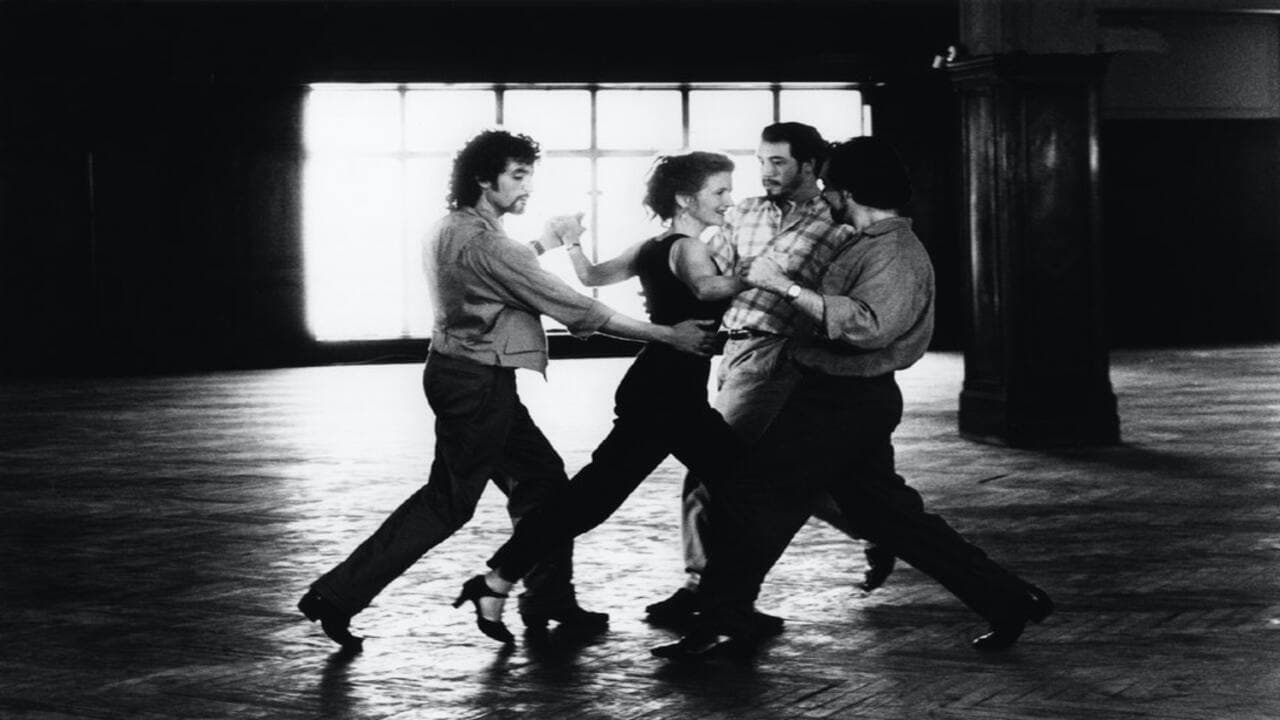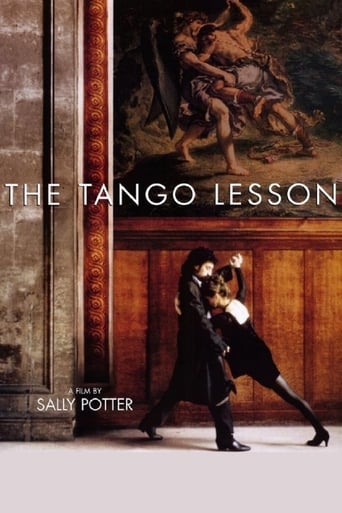

Good start, but then it gets ruined
... View MoreA Masterpiece!
... View MoreA bit overrated, but still an amazing film
... View MoreAmazing worth wacthing. So good. Biased but well made with many good points.
... View MoreI loved this movie for its luminous black and white portraiture of Tango, Buenos Aires and Paris. There's been a few negative comments about Sally's insistence on casting herself in the lead role. A reviewer said that she looked tired; the result of multi-tasking her role as lead and director. I say she has a face that is somewhat care-worn from living a life well which is full of emotional content. It is important to juxtapose the angelic face of Pablo Veron against her much more sage face. A younger more beautiful type would not have worked. She was so smart to think of that; or perhaps it was the fortunate result of looking at the rushes that it came to her. As an art house film it works; the locations are interesting; fragments of spaces and shapes and textures with beautiful lighting. As a study of human relationships it was so painful to watch. I so related to her reluctance to interfere with yet desire to connect with Pablo. Honestly painful. There are also the familiar cast of characters that appear in Sally's other films: Heathcote Williams and Peter Eyre to name 2 that I recognized. I loved Eyre's interaction with Sally; he watched her sadly as she watched Pablo knowing exactly what was going on in her mind. Such an interesting actor with less than 5 minutes on screen time. It is interesting that Maria (one of the Hollywood execs) is an Argentinian born actress pulling off a very good interpretation of an LA beautiful person. Comfortable like a great pair of well worn dance shoes with a patina that just gets better with time. There was just enough there to whet the appetite but like good dancers; they held enough back making you beg for more.
... View MoreMen are traditionally seen as the stronger sex. Men are usually portrayed as being more powerful mentally and in strength than woman. The tango is a very famous and difficult dance that has the man being the stronger of the two sexes. Within the movie The Tango Lesson, directed and written by Sally Potter in 1997, the character Sally starts taking tango lessons by a man named Pablo. During the dance lessons Sally is taught to tango. Within her lessons she is taught to follow the man's lead. While dancing with Pablo, Sally becomes a very good dancer. Pablo asks her to join him in a dance that will take place in front of a very large audience. While they are dancing Sally makes very minor mistakes. While exiting the stage Pablo stays out longer and takes more bows, this can symbolize that he feels that he is the supeiror dancer. When they are off stage Pablo yells at Sally saying that he was "messing up" his dance because she was leading and taking up his space. He said that this prevented him from dancing.That situation shows that Sally is seen as the weaker and less important sex. Sally argues with Pablo that he cant handle the fact that she can lead and will. This shows that she realizes how Pablo is thinking and sees himself when he dances with her. The Tango Dance represents the difference of roles between males and females. Overall it was a very different kind of movie, there wasn't a lot of talking, but there was a lot of very good dancing. This is a good movie to watch if you are learning how to dance the tango or interested in watching movies that show very good dance scenes.
... View More"The Tango Lesson" is one of the strangest movies I've seen. Normally I am very much put off by self-indulgence in any art form. "The Tango Lesson" is nothing if not self-indulgent (as well as self-referential!), yet somehow it all WORKS; even the extremely corny action in the movie shoots that serve to point up Ms. Potter's fictional (or is it real?) frustration with her craft, have some kind of wacky propriety to them in the context of this very unusual story. The dance scene in Pablo's apartment is magical. (And it is hard to believe that he isn't a professional actor.) The scenes with the two tango instructors in Buenos Aires (and indeed all the Argentinian scenes) are touching and beautiful. Ms. Potter's difficulties with her London apartment will be sympathized with by any city apartment dweller!I've seen the film twice in the theater, and once on tape. The second time I enjoyed it even more than the first (because I knew what to expect); the third time I found I'd reached a kind of plateau, but still was sorry when the film was over. This is one of those films I find myself thinking about every single day. It just won't let me alone. I would never call it "great," but I certainly find it memorable, and entertaining even in memory.
... View MoreI have read a lot of commentary on this film. Then I went to the director's website (Sally Potter) and I read her comments.I was so into this movie. It started out slowly and I wasn't sure if I was going to stick with it. But as it went on, I was totally drawn in. I love the fact that the director chose to film it in black and white which only added to the artistry of it. I loved the fact that she as the director, and making it autobiographical, allowed us (the audience) a peek into her creative process. I also love the fact that she courageously placed herself into the hands of another artist to learn the tango. I was impressed when I read that Sally Potter had a background as a dancer so it came naturally to her to appreciate and learn the tango.This movie impressed me on many levels because as a creative talent it takes courage to cross over into the world of another artistic discipline (how easily could a dancer cross over into the world of a film director? you see my point). Or maybe that's not a fair comparison. But to me its literally a case of walking a mile in another man's shoes. Perhaps we find it easy to stand on the sidelines and criticize the work of an artist (be it an actor, director, dancer, writer, etc.) but is it hard to come up with creative visions? Not bloody likely.I viewed this film as a metaphor for life, relationships, artistry, etc. all of which had parallels in the film. If this sounds too deep, it is, believe me! I saw all of this and more in this film.It also felt as if Sally Potter is going through an autobiographical and artistic midlife crisis in this film which has given me courage to put myself on the line autobiographically and artistically. There was some criticism that she should have cast someone else in the title role, but when you can't see anyone playing yourself, but yourself, how can you answer even this kind of criticism?Bravo Sally! I appreciated the peek you gave the audience into your creative process.
... View More